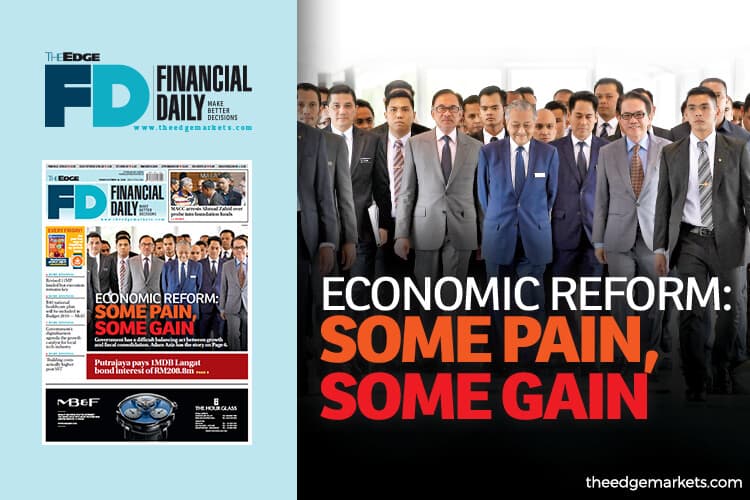
This article first appeared in The Edge Financial Daily on October 19, 2018
KUALA LUMPUR: The government has revised several headline targets in its 11th Malaysia Plan (11MP) (2016-2020) as it sought to balance the objectives of fiscal consolidation with inclusive economic growth.
Among others, the new government has replaced its balanced budget target with a “flexible” 3% deficit by 2020, and expects public investments to contract at an average 0.6% through the five-year period from the 2.7% growth projected previously.
Prime Minister Tun Dr Mahathir Mohamad has described the belt-tightening initiatives as “temporary”, with the trillion-dollar debt incurred by the previous administration partly to blame.
“I am confident that the steps to eradicate leakages and undertake development projects will contribute to economic growth and public well-being,” he said when tabling the Mid-Term Review of the 11MP report in Parliament yesterday.
It has been reported that the Barisan Nasional administration overstated government revenue previously. The former government did not include its massive contingent liabilities in its calculation of national debt, which it assumed at 50.8% of gross domestic product (GDP) previously. The current national debt is at 80.3% of GDP.
Dr Mahathir told reporters later that “the market will react one way or another” but maintained that the steps will improve Malaysia’s performance “economically, politically and socially”.
“[The previous administration] borrowed more than RM1 trillion. Never in the history of Malaysia has a government ever borrowed so much money,” he said, adding that the bulk of government revenue will be used to reduce the debt.
“We cannot reduce the operational budget; that has to go on. The only way we can save money is through reducing the development budget,” he added.
For perspective, RM427.9 billion was expended for operating expenditure during the review period (2016-2017) — representing 98.9% of revenue. Debt service charges, meanwhile, accounted for 12.6% of revenue in 2017, from 9.8% in 2010.
Tighten the belt
The government has cut the development expenditure ceiling by RM40 billion or 15% to RM220 billion from the original allocation of RM260 billion.
According to the report, Malaysia deployed only RM92 billion for development expenditure, mainly financed through debt, as the current account balance was insufficient. The latter is also expected to be lower than initially targeted by 2020.
In relation to that, the government has reverted from a balanced budget target in 2020 to a fiscal deficit of 3% relative to GDP — unchanged from 2017 levels. It was at 3.2% in 2015.
That said, the government sees room to reduce operating expenditure through a better government procurement process such as open tenders, as well as debt restructuring.
The government will introduce more new taxes including digital tax on e-commerce and online sharing economy transactions, as well as other indirect taxes and non-tax revenue such as licences, permits, fees and rentals to replenish the nation’s coffers.
It will also empower agencies to further utilise its assets and maximise cost recovery, thus enhancing non-tax revenue while reducing government dependency.
Investments slowdown expected
Concurrently, the average growth in private investment for the 2016-2020 period has been revised lower to 6.1% from the initial target of 9.4%, although the government said it will “further strengthen the ecosystem” to ensure “high-quality investments”, particularly in the manufacturing and services sectors.
Private investments stood at an average of RM223 billion in the 2016-2017 period, below its revised target of RM252 billion and even lower than its initial target of an average of RM291 billion in 2016-2020.
In the same five-year period, public investment is expected to contract at an average of 0.6% — from the initial target of 2.7% — attributed to the “revision” of major infrastructure projects such as the East Coast Rail Link and Kuala Lumpur-Singapore high-speed rail, said the report.
Hence, the average public investment (in current prices) will be lower at RM107 billion compared with the initial target of RM131 billion.
Average growth in real public consumption is also revised downward to 1.4% from 3.7% previously, the reason being to optimise public expenditure “without affecting the quality of public service delivery”.
There are some upward revisions: Private consumption is expected to average 6.8% in the five years from 6.4% targeted previously, supported by expected favourable labour market conditions and continued growth of income levels.
Other positive target revision include higher average growth of gross exports in the 2016-2020 period, as well as higher trade balances by 2020.
Additionally, the government will continue some 4,000 projects across the nations despite the lower development expenditure ceiling including the building of affordable houses, schools, hospitals, roads and certain big-ticket projects.
The government is also mulling a healthcare scheme that aims to create a national health financing scheme, with the finance ministry confirming yesterday that such scheme for the B40 (bottom 40%) group will be included in Budget 2019.